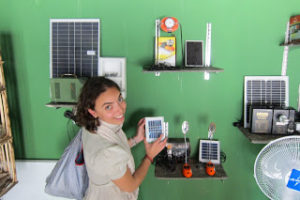Written by Bennett Cohen – originally published by Empower Generation, which merged with Pollinate Energy to form Pollinate Group in 2018
As the EG team readjusts to Nepal to develop our pilot project, we thought a post on our approach was in order. Why women? Why renewable energy? Why now?
Why Women?
Empowering women is at the heart of EG’s approach. As Secretary of State Clinton has emphasized since the first days of the Obama Administration, empowering women should be the foundation of economic development. Currently, over half of the invaluable “human capital” available to developing countries is underutilized because women are not empowered economically.
The EG approach is to reverse this situation through micro-enterprise. Countless international public opinion polls show that the number one thing women want is a job and a stable income. Experience has also shown that women are far less risky when it comes to micro-lending. Women pay back, and are more inclined to focus on their future prosperity. For these reasons, EG favors projects where women play a key role.
Why Renewable Energy?
Many of today’s generation in Nepal has never paid for landline-based telephony. They leapfrogged landlines and went straight to cellular phones. We think it’s likely that as the country electrifies, Nepal will also leapfrog from burning fossil fuel to harnessing sunlight, wind, water, and biomass to generate electricity. After Brazil, the country has the second largest hydroelectric potential in the world, as well as strong winds, bright sunlight, and fertile lands.
The country is also strategically located between India and China, where Renewable Energy Technologies (RETs), such as Photovoltaic cells and microhydroelectric generators, are increasingly produced. Abundant renewable energy and affordable conversion technologies produced next door make renewable electricity the strategic choice for Nepal.
Why Now?
The energy world has reached a tipping point. Renewable energy is not only the sound environmental choice, but also the clear economic choice. For example, the costs of solar continue to plummet, and are hovering at just around $1 per Watt. The life-cycle cost of energy for solar is forecasted to hit 8.6 cents per kilowatt-hour by 2016. The average cost in the U.S. is currently just under 10 cents.
Time is also on the side of renewables. A new coal plant takes years to build. Nuclear plants can take decades. RETs are typically modular, and can be shipped and operational within days or weeks. If you were in a Nepali village without gridpower and your mobile phone needed charging, what source of electricity would you choose?

